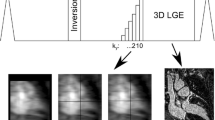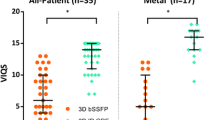Abstract
Background
Pediatric contrast-enhanced MR angiography is often limited by respiration, other patient motion and compromised spatiotemporal resolution.
Objective
To determine the reliability of a free-breathing spatiotemporally accelerated 3-D time-resolved contrast-enhanced MR angiography method for depicting abdominal arterial anatomy in young children.
Materials and methods
With IRB approval and informed consent, we retrospectively identified 27 consecutive children (16 males and 11 females; mean age: 3.8 years, range: 14 days to 8.4 years) referred for contrast-enhanced MR angiography at our institution, who had undergone free-breathing spatiotemporally accelerated time-resolved contrast-enhanced MR angiography studies. A radio-frequency-spoiled gradient echo sequence with Cartesian variable density k-space sampling and radial view ordering, intrinsic motion navigation and intermittent fat suppression was developed. Images were reconstructed with soft-gated parallel imaging locally low-rank method to achieve both motion correction and high spatiotemporal resolution. Quality of delineation of 13 abdominal arteries in the reconstructed images was assessed independently by two radiologists on a five-point scale. Ninety-five percent confidence intervals of the proportion of diagnostically adequate cases were calculated. Interobserver agreements were also analyzed.
Results
Eleven out of 13 arteries achieved acceptable image quality (mean score range: 3.9-5.0) for both readers. Fair to substantial interobserver agreement was reached on nine arteries.
Conclusion
Free-breathing spatiotemporally accelerated 3-D time-resolved contrast-enhanced MR angiography frequently yields diagnostic image quality for most abdominal arteries in young children.




Similar content being viewed by others
References
Olsen ØE (2008) Imaging of abdominal tumours: CT or MRI? Pediatr Radiol 38:452–458
Darge K, Anupindi SA, Jaramillo D (2011) MR imaging of the abdomen and pelvis in infants, children, and adolescents. Radiology 261:12–29
Chung T (2005) Magnetic resonance angiography of the body in pediatric patients: experience with a contrast-enhanced time-resolved technique. Pediatr Radiol 35:3–10
Grist TM, Thornton FJ (2005) Magnetic resonance angiography in children: technique, indications, and imaging findings. Pediatr Radiol 35:26–39
Vasanawala SS, Lustig M (2011) Advances in pediatric body MRI. Pediatr Radiol 41:549–554
Sury MR, Smith JH (2008) Deep sedation and minimal anesthesia. Paediatr Anaesth 18:18–24
Pruessmann KP, Weiger M, Scheidegger MB et al (1999) SENSE: sensitivity encoding for fast MRI. Magn Reson Med 42:952–962
Griswold MA, Jakob PM, Heidemann RM et al (2002) Generalized autocalibrating partially parallel acquisitions (GRAPPA). Magn Reson Med 47:1202–1210
Lustig M, Pauly JM (2010) SPIRiT: iterative self-consistent parallel imaging reconstruction from arbitrary k-space. Magn Reson Med 64:457–471
Lustig M, Donoho D, Pauly JM (2007) Sparse MRI: the application of compressed sensing for rapid MR imaging. Magn Reson Med 58:1182–1195
Pedersen H, Kozerke S, Ringgaard S et al (2009) k-t PCA: temporally constrained k-t BLAST reconstruction using principal component analysis. Magn Reson Med 62:706–716
Liang ZP (2007) Spatiotemporal imaging with partially separable functions. Proceedings of IEEE International Symposium on Biomedical Imaging. Arlington, pp 988–991
Lingala SG, Hu Y, DiBella E et al (2011) Accelerated dynamic MRI exploiting sparsity and low-rank structure: k-t SLR. IEEE Trans Med Imaging 30:1042–1054
Haldar JP, Liang ZP (2011) Low-rank approximations for dynamic imaging. Proceedings of IEEE International Symposium on Biomedical Imaging. Chicago, pp 1052–1055
Trzasko J, Manduca A (2011) Local versus global low-rank promotion in dynamic MRI series reconstruction. Proceedings of the 19th Annual Meeting of ISMRM, Montréal, p 4371
Zhang T, Alley MT, Lustig M et al. (2013) Fast 3D DCE-MRI with sparsity and low-rank enhanced SPIRiT (SLR-SPIRiT). Proceedings of the 21st Annual Meeting of ISMRM, Salt Lake City, p 2624
Zhao B, Haldar JP, Christodoulou AG et al (2012) Image reconstruction from highly undersampled (k, t)-space data with joint partial separability and sparsity constraints. IEEE Trans Med Imaging 31:1809–1820
van Vaals JJ, Brummer ME, Dixon WT et al (1993) “Keyhole” method for accelerating imaging of contrast agent uptake. J Magn Reson Imaging 3:671–675
Tsao J, Boesiger P, Pruessmann KP (2003) k-t BLAST and k-t SENSE: dynamic MRI with high frame rate exploiting spatiotemporal correlations. Magn Reson Med 50:1031–1042
Jung H, Sung K, Nayak KS et al (2009) k-t FOCUSS: a general compressed sensing framework for high resolution dynamic MRI. Magn Reson Med 61:103–116
Huang F, Lin W, Duensing GR et al (2012) k-t sparse GROWL: sequential combination of partially parallel imaging and compressed sensing in k-t space using flexible virtual coil. Magn Reson Med 68:772–782
Feng L, Srichai MB, Lim RP et al (2013) Highly accelerated real-time cardiac cine MRI using k-t SPARSE-SENSE. Magn Reson Med 70:64–74
Trzasko JD, Haider CR, Borisch EA et al (2011) Sparse-CAPR: highly accelerated 4D CE-MRA with parallel imaging and nonconvex compressive sensing. Magn Reson Med 66:1019–1032
Wang K, Busse RF, Holmes JH et al (2011) Interleaved variable density sampling with a constrained parallel imaging reconstruction for dynamic contrast-enhanced MR angiography. Magn Reson Med 66:428–436
Muthupillai R, Vick GW III, Flamm SD et al (2003) Time-resolved contrast-enhanced magnetic resonance angiography in pediatric patients using sensitivity encoding. J Magn Reson Imaging 17:559–564
Vasanawala SS, Alley MT, Hargreaves BA et al (2010) Improved pediatric MR imaging with compressed sensing. Radiology 256:607–616
Zhang T, Chowdhury S, Lustig M et al (2014) Clinical performance of contrast enhanced abdominal pediatric MRI with fast combined parallel imaging compressed sensing reconstruction. J Magn Reson Imaging 40:13–25
Hong TS, Greer ML, Grosse-Wortmann L et al (2011) Whole-body MR angiography: initial experience in imaging pediatric vasculopathy. Pediatr Radiol 41:769–778
Haldar JP (2014) Low-rank modeling of local k-space neighborhoods (LORAKS) for constrained MRI. IEEE Trans Med Imaging 33:668–681
Ehman RL, McNamara MT, Pallack M et al (1984) Magnetic resonance imaging with respiratory gating: techniques and advantages. AJR Am J Roentgenol 143:1175–1182
Batchelor PG, Atkinson D, Irarrazaval P et al (2005) Matrix description of general motion correction applied to multishot images. Magn Reson Med 54:1273–1280
Odille F, Vuissoz PA, Marie PY et al (2008) Generalized reconstruction by inversion of coupled systems (GRICS) applied to free-breathing MRI. Magn Reson Med 60:146–157
Buerger C, Schaeffter T, King AP (2011) Hierarchical adaptive local affine registration for fast and robust respiratory motion estimation. Med Image Anal 15:551–564
Cheng JY, Alley MT, Cunningham CH et al (2012) Nonrigid motion correction in 3D using autofocusing with localized linear translation. Magn Reson Med 68:1785–1797
Johnson KM, Block WF, Reeder SB et al (2012) Improved least squares MR image reconstruction using estimates of k-space data consistency. Magn Reson Med 67:1600–1608
Forman C, Piccini D, Grimm R et al (2015) Reduction of respiratory motion artifacts for free-breathing whole-heart coronary MRA by weighted iterative reconstruction. Magn Reson Med 73:1885–1895
Cheng JY, Zhang T, Ruangwattanapaisarn N et al (2014) Free-breathing pediatric MRI with nonrigid motion correction and acceleration. J Magn Reson Imaging. doi:10.1002/jmri.24785
Jhooti P, Wiesmann F, Taylor AM et al (1998) Hybrid ordered phase encoding (HOPE): an improved approach for respiratory artifact reduction. J Magn Reson Imaging 8:968–980
Doneva M, Stehning C, Nehrke K, et al P (2011) Improving scan efficiency of respiratory gated imaging using compressed sensing with 3D Cartesian golden angle sampling. Proceedings of the 19th Annual Meeting of ISMRM, Montréal, p 641
Gdaniec N, Eggers H, Börnert P et al (2014) Robust abdominal imaging with incomplete breath-holds. Magn Reson Med 71:1733–1742
Cheng JY, Zhang T, Alley MT et al. (2013) Variable-density radial view-ordering and sampling for time-optimized 3D Cartesian imaging. Proceedings of the ISMRM Workshop on Data Sampling and Image Reconstruction, Sedona
Zhang T, Cheng JY, Potnick AG et al (2015) Fast pediatric 3D free-breathing abdominal dynamic contrast enhanced MRI with high spatiotemporal resolution. J Magn Reson Imaging 41:460–473
Zhang T, Pauly JM, Vasanawala SS et al (2013) Coil compression for accelerated imaging with Cartesian sampling. Magn Reson Med 69:571–582
Newcombe RG (1998) Two-sided confidence intervals for the single proportion: comparison of seven methods. Statist Med 17:857–872
Acknowledgments
This work was supported by NIH grants R01 EB009690, R01 EB019241, P41 EB015891, the Tashia and John Morgridge Faculty Scholars Fund and GE Healthcare.
Conflicts of interest
T. Zhang, J. Y. Cheng, M. T. Alley, M. Lustig, J. M. Pauly and S. S. Vasanawala collaborate on research with GE Healthcare.
Author information
Authors and Affiliations
Corresponding author
Rights and permissions
About this article
Cite this article
Zhang, T., Yousaf, U., Hsiao, A. et al. Clinical performance of a free-breathing spatiotemporally accelerated 3-D time-resolved contrast-enhanced pediatric abdominal MR angiography. Pediatr Radiol 45, 1635–1643 (2015). https://doi.org/10.1007/s00247-015-3384-y
Received:
Revised:
Accepted:
Published:
Issue Date:
DOI: https://doi.org/10.1007/s00247-015-3384-y




